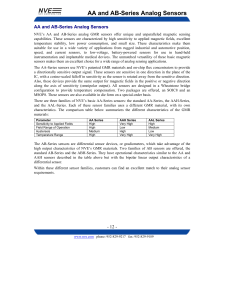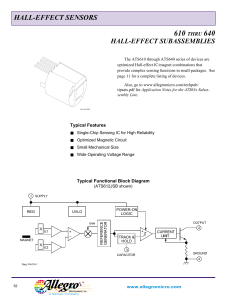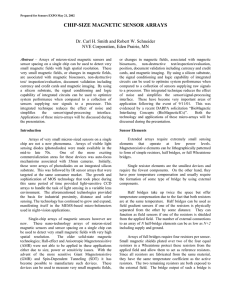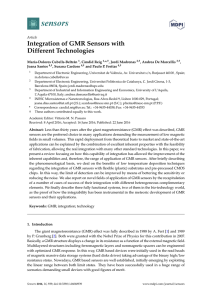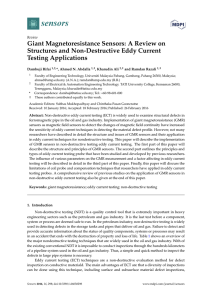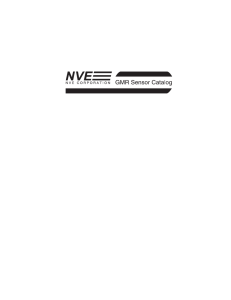Lecture 10: Sensors 2.996/6.971 Biomedical Devices Design Laboratory Instructor: Dr. Hong Ma
advertisement
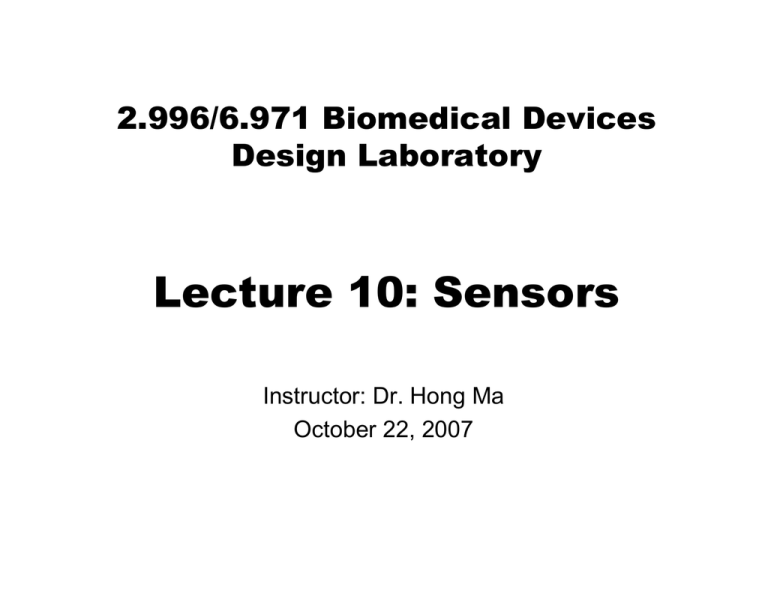
2.996/6.971 Biomedical Devices Design Laboratory Lecture 10: Sensors Instructor: Dr. Hong Ma October 22, 2007 Switches • Pull-ups and pull-down • De-bouncing Reed Switches Image removed due to copyright restrictions. • Magnetically operated • Non-contact operation • Door open/close detection Piezoresistive Strain Gages dR dl dl = (1 + 2υ + C (1 − 2υ ) ) = G = Gε R l l • Gage factor – Common metals G~2-3 – Platinum G=6 – Semiconductors G~40-200 • Metals have greater elongation limits – Constantan foil: • Up to 3-5% elongation • G=2 – Higher strains are limited by bonding Images removed due to copyright restrictions. Force Sensitive Resistors (FSR) • Pressure sensitive polymer – Decrease in resistance with applied pressure • Not suitable for precision measurements! – Force accurace range from ±5 to ±25% • Repeatable mechanics is key! Image removed due to copyright restrictions. Photoresistor (Light-Dependent Resistor) • • • • • • Very slow (response time ~100ms) Hysteresis behavior CdS ~ 480nm ZnS ~ 320nm CdSe ~ 720nm PbS ~ 2000nm Image removed due to copyright restrictions. Resistance Measurement Circuits • Quick-and-dirty techniques: – Trans-impedance amplifier – Resistive divider – Timer-comparator Result only dependent on the ratios of the test and reference resistors Wheatstone Bridge • Match resistors to remove common-mode interference • Not linear • Linearize using multiple sensors Instrumentation Amplifier • Available as a packaged amplifier, e.g. INA118 • RG and VREF accessible externally Servo’ed Split Bridge • Vout = -x*Vin/2 • Require dual supplies if x>0 Capacitance (E-field) Sensing • Cost effective Image removed due to copyright restrictions. • Infinite resolution • Require transient excitation signal Cap Sensing – The quick and dirty way • Exchange the resistor and capacitor • Measure capacitor discharge time Low-Impedance Method High-Impedance Method Conventional Pin-Out OPA129 Pin-Out Magnetic Field Sensing • H-field – Applied field – Units (CGS): Oe (Oersted) – Units (SI): Ampere Turns / Meter • B-field – – – – Applied + induced field B = µ(H + M) Units (CGS): Gauss Units (SI): Tesla (1 Tesla = 104 Gauss) • In air (in CGS units): 1 Oe = 1 Gauss • Earth’s magnetic field: 0.3 – 0.6 Gauss • Sensitivities: – Hall-effect: >50 Oe – GMR: 0.1 to 0.5 Oe Hall-effect Sensors • • • • Ubiquitous Low cost Non-contact Line-of-sight not required • Poor accuracy – >50 Oe magnetic field required • Generally used in switch mode Applications of Magnetic Sensors Giant Magnetoresistance (GMR) Image removed due to copyright restrictions. • Nobel Prize in Physics 2007 • Discovered in 1988, brought to market in 1997 • Albert Fert (France) and Peter Grünberg (Germany) Spin-Dependent Conduction • ~5nm layers • Section 2 could be a conductor or insulator • Practically 8 - 12% conductivity change GMR Sensors from NVE Hysteresis and Biasing • All magnetic materials exhibit hysteresis behavior



